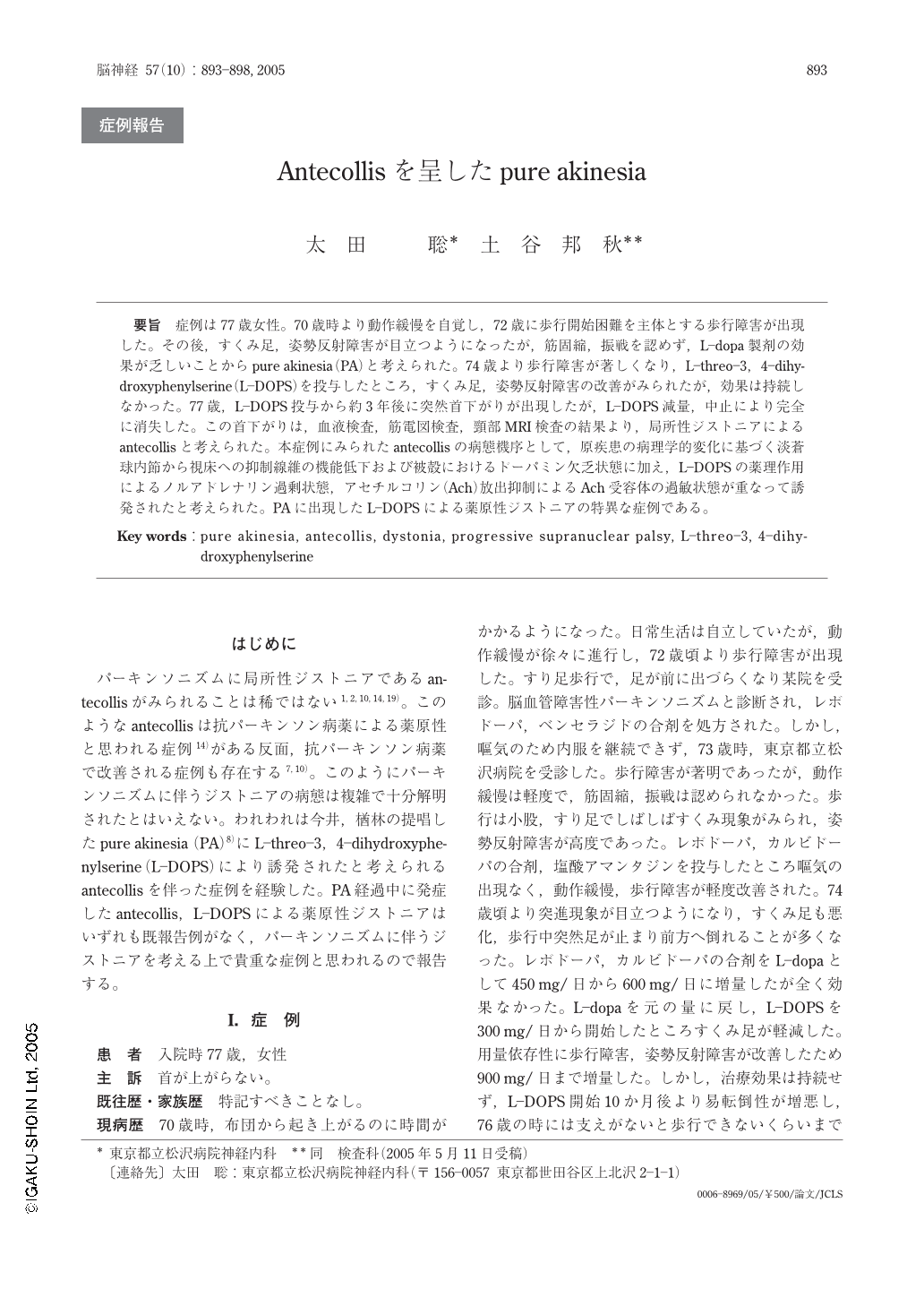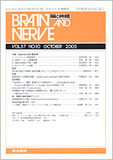Japanese
English
- 有料閲覧
- Abstract 文献概要
- 1ページ目 Look Inside
要旨 症例は77歳女性。70歳時より動作緩慢を自覚し,72歳に歩行開始困難を主体とする歩行障害が出現した。その後,すくみ足,姿勢反射障害が目立つようになったが,筋固縮,振戦を認めず,L-dopa製剤の効果が乏しいことからpure akinesia(PA)と考えられた。74歳より歩行障害が著しくなり,L-threo-3,4-dihydroxyphenylserine(L-DOPS)を投与したところ,すくみ足,姿勢反射障害の改善がみられたが,効果は持続しなかった。77歳,L-DOPS投与から約3年後に突然首下がりが出現したが,L-DOPS減量,中止により完全に消失した。この首下がりは,血液検査,筋電図検査,頸部MRI検査の結果より,局所性ジストニアによるantecollisと考えられた。本症例にみられたantecollisの病態機序として,原疾患の病理学的変化に基づく淡蒼球内節から視床ヘの抑制線維の機能低下および被殻におけるドーパミン欠乏状態に加え,L-DOPSの薬理作用によるノルアドレナリン過剰状態,アセチルコリン(Ach)放出抑制によるAch受容体の過敏状態が重なって誘発されたと考えられた。PAに出現したL-DOPSによる薬原性ジストニアの特異な症例である。
We reported a 77-year-old woman having pure akinesia who presented with antecollis induced by L-threo-3, 4-dihydroxyphenylserine (L-DOPS). At the age of 70, she noticedlt increasing difficulty in standing up from a seat and moving. Afterward, she developed gait disturbance with difficulty in initiating walking, frozen gait, and postural instability. At 73 years of age, she came to our hospital, because she gradually fell down easily. Neurological examination disclosed mild akinesia with freezing symptom and kinésie paradoxale. No evidence of dementia, supranuclear gaze palsy, pseudobulbar palsy, rigidity, or tremor were present. As she developed akinesia, of which L-dopa therapy achieved little improvement, we clinically diagnosed as having pure akinesia. At age 74, L-DOPS was administered at a dose of 300mg per day and gradually increased up to 900mg per day, because her postural reflex was markedly disturbed and gait showed severe unsteadiness. Amelioration of frozen gait and unsteadiness were recognized, but efficacy of L-DOPS was temporal. It is well known that reported cases of pure akinesia were pathologically diagnosed as having progressive supranuclear palsy (PSP) or pallido-nigro-luysian atrophy. Therefore, the present case was suspected as having pathological changes which involved degeneration of the substantia nigra and globus pallidus. After three years of treatment with L-DOPS, at age 77, she was admitted to our hospital for abrupt onset of her dropped head. Hematological examinations were normal, cervical MRI showed no evidence of paracervical muscular atrophy, and electromyography did not demonstrate any abnormal change. In addition, her posterior cervical muscles showed abnormally high tension, so the dropped head was considered due to antecollis. After admission, antecollis disappeared rapidly following discontinuation of L-DOPS. However the mechanism of drug induced dystonia is imperfectly understood on the basis of the clinical course, L-DOPS was considered as possible cause of her antecollis. L-DOPS, artificial precursor of noradrenarine(NA), is thought to increase not only NA level in the CNS, but also inhibit release of acetylcholine. It is suggested that the antecollis of present case results from impairment of a normal dopaminergic-noradorenergic balance caused by increased NA and striatal dopamine deficiency. This is the first case of antecollis induced by L-DOPS in a pure akinesia patient, providing important information on mechanism of drug induced dystonia and indicating caution in the clinical use of L-DOPS.
(Received : May 11, 2005)

Copyright © 2005, Igaku-Shoin Ltd. All rights reserved.


